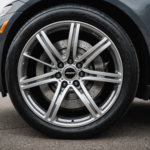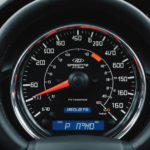Understanding how wheel diameter influences tire size selection is crucial for vehicle performance, safety, and aesthetics. The diameter of the wheel impacts various factors, including ride comfort, handling characteristics, fuel efficiency, and driving dynamics. This article explores the significance of wheel diameter, its relationship with tire sizes, and the factors to consider when selecting tires for your vehicle. Moreover, it will provide insightful tables, lists, and formulas to help unravel the complexities of tire selection.
Understanding Wheel Diameter
The wheel diameter refers to the distance across the wheel from one edge to the opposite edge, measured in inches or millimeters. The wheel’s diameter plays a pivotal role in how a vehicle interacts with the road. Different diameters accommodate various tire sizes, influencing grip, handling, and ride quality.
The Importance of Wheel Diameter
- Performance: Larger wheels typically enhance handling performance. They provide a larger contact patch with the road, improving traction and stability.
- Ride Comfort: Smaller wheels with taller tires tend to absorb road imperfections better, providing a smoother ride.
- Aesthetics: The size of the wheels can significantly affect the visual appeal of a vehicle. Larger wheels often contribute to a sportier look.
How Wheel Diameter Affects Tire Size
Tire size is denoted by a series of alphanumeric characters, such as P215/65R15, where each segment represents specific dimensions and characteristics of the tire. The first number indicates the tire’s width, the second represents the aspect ratio (the height of the tire’s sidewall compared to its width), and the last number indicates the wheel diameter the tire is designed to fit.
The Relationship Between Wheel Diameter and Tire Sizes
The relationship between the wheel diameter and appropriate tire sizes is typically governed by a set of industry standards. When selecting tires, it is essential to ensure that the tires are compatible with the wheel diameters to maintain safety and performance. Here are some essential notes regarding this relationship:
| Wheel Diameter (inches) | Typical Tire Size Range | Aspect Ratio Range |
|---|---|---|
| 14 | P175/65R14 – P195/70R14 | 60-75 |
| 15 | P195/60R15 – P225/70R15 | 55-75 |
| 16 | P205/55R16 – P235/60R16 | 50-70 |
| 17 | P215/50R17 – P245/70R17 | 45-75 |
| 18 | P225/45R18 – P265/65R18 | 40-70 |
Choosing the Right Tire Size
When selecting the right tire size for a specific wheel diameter, consider the following factors:
- Manufacturer Guidelines: Always consult the vehicle manufacturer’s specifications to determine the recommended tire size for your wheel diameter.
- Driving Conditions: Different driving conditions require different tire characteristics; for example, larger tires may be better for off-road adventures, while smaller tires are often preferable for city driving.
- Aesthetic Preferences: Consider whether the appearance is a primary factor in tire selection. Larger wheels may provide a more aggressive stance, while smaller wheels can look more classic.
- Tire Performance Factors: Assess various performance metrics, such as grip, fuel efficiency, and ride comfort, as these can vary significantly even within the same diameter.
The Effect of Wheel Diameter on Tire Performance
Beyond aesthetics and fitment, the wheel diameter can dramatically influence the overall performance of a vehicle. The performance characteristics of tires chosen for different wheel diameters can determine handling, stability, fuel economy, and ride comfort.
Ride Comfort and Handling
The aspect ratio (height of the tire’s sidewall) plays a critical role alongside the wheel diameter. A higher aspect ratio often denotes a taller tire, which results in a softer ride due to increased cushioning against road imperfections. In contrast, lower aspect ratio tires (often paired with larger wheels) tend to be stiffer, enhancing handling and cornering performance but compromising ride comfort.
Fuel Efficiency
Fuel efficiency can also be influenced by wheel diameter. Larger wheels and tires generally increase the unsprung weight, which can affect acceleration and deceleration. It may require more power to turn larger wheels, leading to increased fuel consumption. Thus, selecting a wheel diameter must consider the trade-off between aesthetics, handling, and efficiency.
Common Misconceptions About Wheel Diameter and Tire Size
Several misconceptions exist regarding wheel diameter and tire size selection that can lead drivers to make erroneous choices. Below are some frequent myths debunked:
Myth 1: Bigger Wheels Always Mean Better Performance
While larger wheels can enhance handling performance, they may come at the cost of ride comfort and fuel efficiency. It is essential to find a balance based on personal preferences and driving conditions.
Myth 2: Any Tire Will Fit Any Wheel Size
This statement is entirely false. Tires must be specifically fitted to match the wheel diameter and width. Failure to do so can lead to unsafe driving conditions.
Myth 3: Changing Wheel Diameter Doesn’t Affect Speedometer Accuracy
A change in wheel diameter can influence speedometer readings. Larger tires can make the speedometer read lower than the actual speed, while smaller tires can make it read higher. Users should recalibrate their speedometers if they change their tire size significantly.
Final Considerations for Tire and Wheel Compatibility
When selecting the appropriate tire size, it is vital to weigh several factors beyond just wheel diameter. Compatibility with factors such as load index, speed rating, and performance attributes is equally important. Below are some final considerations:
Load Index and Speed Rating
Tires are rated for load capacity and maximum speed. Ensure that the selected tire can support the weight of the vehicle while matching the required speed rating. Consult the manufacturer’s specifications for this data.
Regulations and Typologies
Different regions may have unique regulations regarding tire sizes. Always check local laws concerning tire specifications to stay compliant.
Consult with Professionals
For optimal safety and performance, it is advisable to consult tire and automotive professionals when selecting tires based on wheel diameter.
Conclusion
In summary, understanding the role of wheel diameter in tire size selection is essential for vehicle owners. The relationship between these two components affects numerous performance metrics, ride comfort, and driving experience. By taking into account various factors—such as manufacturer recommendations, driving conditions, and personal preferences—drivers can make informed decisions about their tire selection. Ensuring compatibility with the right wheel diameter and understanding its implications will lead to safer, more efficient, and enjoyable driving experiences. Investing time in understanding these factors can bring significant long-term benefits in maintaining your vehicle’s performance and aesthetics.
This article provides a comprehensive analysis of the role of wheel diameter in tire selection, while following the specified guidelines for HTML formatting and structure.




















